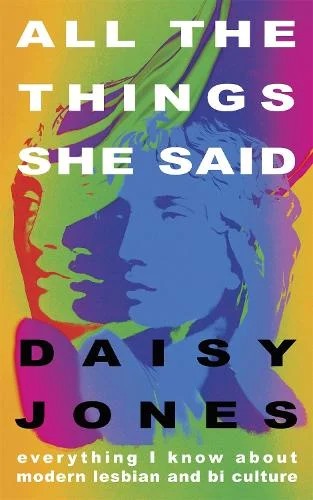Putting queer women into the mainstream, All The Things She Said is the book that queer, lesbian and bi women everywhere have been waiting for. Look no further than the iconic title after t.A.T.u.’s iconic 2002 hit. And yes, we know you’re now singing it in your head. So are we.
So very rarely have books documenting the lives of lesbian, bisexual and queer women hit the mainstream with such style and hook as this. With its bright, zappy cover, the title nostalgically instils perhaps the most notable queer, racy coming-of-age moment in all of us.
Putting queer women in the mainstream
Until very recently, it would be a struggle to find any book quite like this. You would normally only be able to find books of this ilk in academia. Or in underground or independent spots or the dusty and outdated LGBTQ+ sections of libraries and bookshops. You might be lucky for one of those books to briefly touch on social media or contemporary culture beyond the 2000s. Even the mention of a famous popstar you know, being queer. If you’re lucky.
Daisy Jones has refreshed the WLW encyclopaedia for the modern woman. As Jones notes defiantly in her book, so much about the perception of queer women and culture has changed in just a matter of decades. Even from the turn of the millennium so much has changed. Social media continues to trailblaze the trends of culture and swarms of TikTok videos continue to sprawl across the internet. The cultural shifts are happening more quickly than ever.
How lesbian and bi culture went from being the butt of everyone’s joke… to all your straight mates suddenly cutting in homemade mullets and wearing thumb rings and calling Meryl Streep ‘Daddy’.
Daisy jones
All The Things She Said chronicles all the ways in which queer women’s culture has permeated contemporary culture. Now, it comes with a fresh layer of desirability in a way that queer women’s culture has never been accoladed with before. Jones debunks all the common stereotypes of the past, how lesbians have either been hypersexualised or depicted as completely sexless, and highlights how being a queer woman in 2021 is now, well, sexy, but with agency. It’s powerful… it’s… cool to be queer now. Hard for your teenage self to have imagined one day, right?
How queer culture became ‘cool’
Jones describes ‘how lesbian and bi culture went from being the butt of everyone’s joke… to all your straight mates suddenly cutting in homemade mullets and wearing thumb rings and calling Meryl Streep ‘Daddy’.’
She then highlights how ‘lesbian and bi culture went from being something you associate with those two middle-aged ‘aunts’ in your mum’s village with the spiked frosted tips to having screenwriter Lena Waithe grace the cover of Vanity Fair in a white tee and chain, shoulders hunched and casual, eyes staring straight into the camera with what I can only describe as a ‘powerful lesbian expression’.
Furthermore, Jones succeeds in illustrating how queer theory and lived experience have segmented the labels we use to denote gender and sexual identities beyond the binary of straight vs gay or man vs woman. She calls upon queer academics and accounts of real individuals Daisy has interviewed to further explore the nuances and intricacies of how these identities align and converge.
Making some noise for representation, and Cate Blanchett…
Daisy then highlights the importance of queer women’s representation on TV and film. She dives into the impact of The L Word, Sugar Rush and our favourite WLW films like Carol. The book even features an entire chapter on film that may as well be called the Cate Blanchett chapter. And we are so here for it. The iconic @DykeBlanchett Instagram account even gets a mention.
There’s even a whole segment on Lesbians of TikTok and the like. What isn’t there in this book?
The narrative dips its toe into academic study and queer history, whittling it down to warrant accessible comprehension, keeping its light-hearted and entertaining tone bobbing along the surface to epically chronicle the iconic culture of modern queer women in its process.
The book’s helm, though, is the way it cements a sense of unity that queer women can now experience together in retrospect. Sprinkled with an added dose of yearnful nostalgia, naturally.
Jones shares the cultural touchpoints we are probably all incredibly familiar with. We probably experienced them alone in the darkness of our teenage bedrooms. Deleting our Google search histories. Keeping our Tumblr accounts a secret from school friends. Searching ‘girls kissing’ on YouTube and discovering shows like Lost Girl or Orphan Black. Rewatching all the Emily and Naomi episodes of Skins. Discovering Tegan and Sara. There is proof now that there were fellow people everywhere doing exactly the same thing.
We were always here and we always will be, we just get more stylish with time.
For more reading suggestions, head on over to our Books section here at Nonchalant. x


